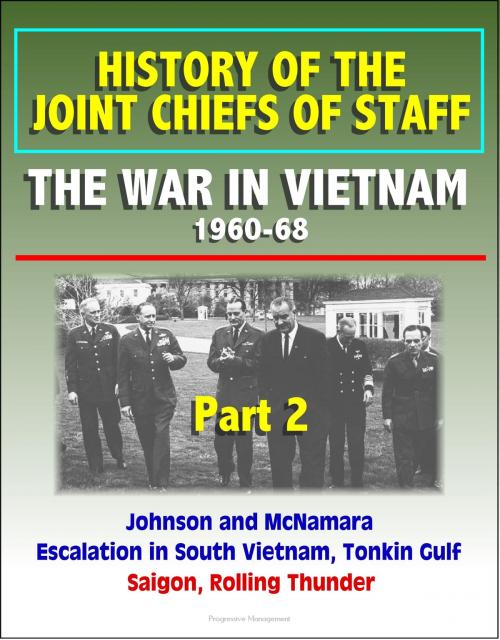History of the Joint Chiefs of Staff: The War in Vietnam 1960-1968, Part 2 - Johnson and McNamara, Escalation in South Vietnam, Tonkin Gulf, Saigon, Rolling Thunder
Nonfiction, History, Asian, Southeast Asia, Military, Vietnam War| Author: | Progressive Management | ISBN: | 9781301133581 |
| Publisher: | Progressive Management | Publication: | October 3, 2013 |
| Imprint: | Smashwords Edition | Language: | English |
| Author: | Progressive Management |
| ISBN: | 9781301133581 |
| Publisher: | Progressive Management |
| Publication: | October 3, 2013 |
| Imprint: | Smashwords Edition |
| Language: | English |
This volume describes those JCS activities related to developments in Vietnam during the period 1964-1966. At times, the role of the Joint Chiefs in events in Vietnam may appear to be submerged in the description of foreign relations, politics, economics, and other areas having little to do with military matters. However, developments in these areas provide essential background for understanding the military activity of the 1960s.
- President Johnson's First Months * 2. Johnson's Course Confirmed, NSAM 288 * 3. Command Reorganization in South Vietnam * 4. An Escalation Scenario Takes Shape * 5. New Faces in Saigon and More Troops * 6. Going North: Tonkin Gulf and Its Effects * 7. US Action Awaits Stability in Saigon * 8. The Bien Hoa Attack and the US Reaction * 9. A New Presidential Decision * 10. Implementing the Presidential Decisions * 11. A New Stage of US Commitment * 12. The Quantum Jump—ROLLING THUNDER * 13. Limited Deployment of US Forces * 14. The Logistics of Escalation * 15. Deployment Planning, March-June 1965 * 16. Into the Battle, June 1965-February 1966 * 17. Command Arrangements and Allies * 18. Military Operations, July-December 1965 * 19. ROLLING THUNDER Continues * 20. The Search for Peace Begins * 21. ROLLING THUNDER Resumes and Expands * 22. Deployments and Forces, 1966 * 23. The War in South Vietnam - 1966 * 24. The Air, the Sea, and the Borders * 25. Logistics Issues, 1966 * 26. ROLLING THUNDER, July 1966-January 1967 * 27. Efforts toward Negotiation
Prologue: At the End of 1963 * The Deaths of Two Presidents * The Joint Chiefs of Staff under Kennedy and Johnson * The Joint Chiefs of Staff and Vietnam: Five Silent Men? * 1. President Johnson's First Months * 1964: A New Year Begins * President Johnson Sets a Course: NSAM 273 * Planning for Actions against North Vietnam * The Khanh Coup, 30 January 1964 * OPLAN 34A Starts Slowly * Encouraging Steps in Pacification * New Organization and Planning in Washington * The JCS Recommendations of 22 January 1964 * JCS Planning after the Khanh Coup * Decisions in Hanoi * 2. Johnson's Course Confirmed, NSAM 288 * JCS Recommendations to McNamara * The JCS Push for Cross-Border Operations * Blockading North Vietnam: Problems Identified * McNamara's March Trip and Report * JCS Views on the McNamara Report * Approval of the 12 Recommendations: NSAM 288 * Implementing NSAM 288: South Vietnamese Forces * Implementing NSAM 288: Cross-Border Operations * Aerial Reconnaissance in Laos: YANKEE TEAM * Implementing NSAM 288: Future Operations * The JCS Develop a Target List * 3. Command Reorganization in South Vietnam * General Harkins' Last Months * Reorganizing MACV * MACV: A Joint or Army Command? * 4. An Escalation Scenario Takes Shape * General Khanh Takes a New Tack * McNamara's May Visit to South Vietnam * Escalation Planning Intensifies * A Scenario is Written * The JCS in the Preparations for Honolulu * The Honolulu Conference, 1-2 June 1964 * After the Honolulu Conference * General Taylor Defines Patterns of Attack * A Vision of Regional War: CINCPAC OPLAN 38-64 * Status of Recommendations 11 and 12, NSAM 288 * 5. New Faces in Saigon and More Troops * Changes in Command * Ambassador Taylor Takes Charge * A Major Increase in US Military Personnel * Americans in Vietnam: Advisers or Fighters? * Accommodating the Forces * The Search for "More Flags" Begins * 6. Going North: Tonkin Gulf and Its Effects * General Khanh Calls for a Move North * Ambassador Taylor Proposes Combined Planning * The Joint Chiefs Recommend Additional Action * The Gulf of Tonkin Incident * The Joint Congressional Resolution * The United Nations and Communist Response * The View from Saigon * Continued Policy Deliberations in Washington * 7. US Action Awaits Stability in Saigon * The Khanh Regime Stumbles * Ambassador Taylor on Escalation * The JCS Recommendations of 26 August * The 94 Target List
This volume describes those JCS activities related to developments in Vietnam during the period 1964-1966. At times, the role of the Joint Chiefs in events in Vietnam may appear to be submerged in the description of foreign relations, politics, economics, and other areas having little to do with military matters. However, developments in these areas provide essential background for understanding the military activity of the 1960s.
- President Johnson's First Months * 2. Johnson's Course Confirmed, NSAM 288 * 3. Command Reorganization in South Vietnam * 4. An Escalation Scenario Takes Shape * 5. New Faces in Saigon and More Troops * 6. Going North: Tonkin Gulf and Its Effects * 7. US Action Awaits Stability in Saigon * 8. The Bien Hoa Attack and the US Reaction * 9. A New Presidential Decision * 10. Implementing the Presidential Decisions * 11. A New Stage of US Commitment * 12. The Quantum Jump—ROLLING THUNDER * 13. Limited Deployment of US Forces * 14. The Logistics of Escalation * 15. Deployment Planning, March-June 1965 * 16. Into the Battle, June 1965-February 1966 * 17. Command Arrangements and Allies * 18. Military Operations, July-December 1965 * 19. ROLLING THUNDER Continues * 20. The Search for Peace Begins * 21. ROLLING THUNDER Resumes and Expands * 22. Deployments and Forces, 1966 * 23. The War in South Vietnam - 1966 * 24. The Air, the Sea, and the Borders * 25. Logistics Issues, 1966 * 26. ROLLING THUNDER, July 1966-January 1967 * 27. Efforts toward Negotiation
Prologue: At the End of 1963 * The Deaths of Two Presidents * The Joint Chiefs of Staff under Kennedy and Johnson * The Joint Chiefs of Staff and Vietnam: Five Silent Men? * 1. President Johnson's First Months * 1964: A New Year Begins * President Johnson Sets a Course: NSAM 273 * Planning for Actions against North Vietnam * The Khanh Coup, 30 January 1964 * OPLAN 34A Starts Slowly * Encouraging Steps in Pacification * New Organization and Planning in Washington * The JCS Recommendations of 22 January 1964 * JCS Planning after the Khanh Coup * Decisions in Hanoi * 2. Johnson's Course Confirmed, NSAM 288 * JCS Recommendations to McNamara * The JCS Push for Cross-Border Operations * Blockading North Vietnam: Problems Identified * McNamara's March Trip and Report * JCS Views on the McNamara Report * Approval of the 12 Recommendations: NSAM 288 * Implementing NSAM 288: South Vietnamese Forces * Implementing NSAM 288: Cross-Border Operations * Aerial Reconnaissance in Laos: YANKEE TEAM * Implementing NSAM 288: Future Operations * The JCS Develop a Target List * 3. Command Reorganization in South Vietnam * General Harkins' Last Months * Reorganizing MACV * MACV: A Joint or Army Command? * 4. An Escalation Scenario Takes Shape * General Khanh Takes a New Tack * McNamara's May Visit to South Vietnam * Escalation Planning Intensifies * A Scenario is Written * The JCS in the Preparations for Honolulu * The Honolulu Conference, 1-2 June 1964 * After the Honolulu Conference * General Taylor Defines Patterns of Attack * A Vision of Regional War: CINCPAC OPLAN 38-64 * Status of Recommendations 11 and 12, NSAM 288 * 5. New Faces in Saigon and More Troops * Changes in Command * Ambassador Taylor Takes Charge * A Major Increase in US Military Personnel * Americans in Vietnam: Advisers or Fighters? * Accommodating the Forces * The Search for "More Flags" Begins * 6. Going North: Tonkin Gulf and Its Effects * General Khanh Calls for a Move North * Ambassador Taylor Proposes Combined Planning * The Joint Chiefs Recommend Additional Action * The Gulf of Tonkin Incident * The Joint Congressional Resolution * The United Nations and Communist Response * The View from Saigon * Continued Policy Deliberations in Washington * 7. US Action Awaits Stability in Saigon * The Khanh Regime Stumbles * Ambassador Taylor on Escalation * The JCS Recommendations of 26 August * The 94 Target List















